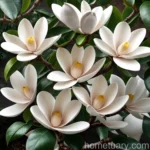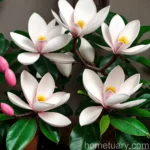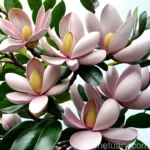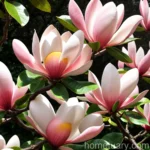Oyama Magnolia (Magnolia sieboldii): A Comprehensive Guide
Magnolia sieboldii, commonly known as Oyama magnolia, is a captivating flowering shrub native to Japan and Korea. This exquisite plant is revered for its large, fragrant white flowers and lush foliage, making it a popular choice among gardeners and horticulturists. In this comprehensive guide, we will delve into the various aspects of Oyama Magnolia, including its culture, uses, care requirements, propagation, common diseases, and much more. Whether you are an avid gardener, a botany enthusiast, or simply someone who appreciates the beauty of nature, this guide will provide you with valuable insights into this stunning plant.

What is Oyama Magnolia (Magnolia sieboldii)?
Oyama magnolia, scientifically known as Magnolia sieboldii, belongs to the Magnoliaceae family and is prized for its ornamental value. This deciduous shrub typically reaches a height of 8 to 20 feet, with a spread of 8 to 15 feet, creating a substantial presence in the landscape. The plant features large, saucer-shaped white flowers with a hint of pale pink at the base, exuding a delightful fragrance that captures the essence of spring. The leathery, dark green leaves provide an excellent backdrop for the blossoms, adding to the visual appeal of the plant.
Key Takeaways – Oyama Magnolia (Magnolia sieboldii)
Before we delve into the specifics of Oyama magnolia care, let’s outline some key takeaways about this remarkable plant:
- Oyama magnolia is a deciduous shrub known for its large, fragrant white flowers and dark green foliage.
- The plant belongs to the Magnoliaceae family and is native to Japan and Korea.
- Oyama magnolia thrives in well-drained, acidic soil and prefers partial shade to full sun.
- It is prized for its ornamental value and is commonly used in gardens, landscapes, and urban settings.
- Proper care, including watering, pruning, and fertilization, is crucial for the optimal growth of Oyama magnolia.
Now that we have a basic understanding of Oyama magnolia, let’s explore the essential aspects of its culture, uses, and care requirements.
Culture
Cultivating Oyama magnolia involves understanding its specific cultural requirements, including water, sunlight, soil, and fertilization. By providing the ideal growing conditions, you can ensure the health and vitality of this magnificent shrub.
Water
Proper watering is essential for the well-being of Oyama magnolia, especially during its establishment phase and periods of drought. Here are some key points to consider regarding watering requirements:
| Watering Requirements | Details |
|---|---|
| Soil Moisture | Oyama magnolia thrives in well-drained soil that retains moisture without becoming waterlogged. Ensure that the soil does not dry out completely, especially during the plant’s active growth periods. |
| Watering Schedule | Newly planted Oyama magnolia shrubs should be watered regularly to promote root establishment. During dry spells, provide supplemental watering to prevent moisture stress. |
| Mulching | Applying a layer of organic mulch around the base of the plant helps retain soil moisture and prevents rapid evaporation. Mulch also aids in regulating soil temperature and inhibiting weed growth. |
Sunlight
Oyama magnolia exhibits a preference for partial shade to full sun, thriving in locations that provide adequate light without excessive exposure to intense midday sun. Consider the following sunlight requirements:
| Sunlight Needs | Details |
|---|---|
| Ideal Conditions | Plant Oyama magnolia in a location that receives morning sun and partial shade in the afternoon, especially in regions with hot summers. Partial shade provides protection from intense sunlight, preventing leaf scorch and promoting optimal growth and flowering. |
| Sun Exposure | Ensure that the plant receives at least 4-6 hours of direct sunlight daily to stimulate robust flowering and maintain healthy foliage. However, it is important to avoid prolonged exposure to harsh afternoon sun, particularly in warmer climates. |
Fertilizer
Fertilization plays a pivotal role in nourishing Oyama magnolia and supporting its growth and flowering capabilities. Carefully select and apply the appropriate fertilizers to meet the plant’s nutritional needs:
| Fertilization Guidelines | Details |
|---|---|
| Fertilizer Type | Utilize a balanced, slow-release fertilizer formulated for acid-loving plants, as Oyama magnolia thrives in acidic soil conditions. The fertilizer should contain micronutrients such as iron, manganese, and magnesium to support the plant’s overall health. |
| Application Frequency | Apply fertilizer in early spring before new growth emerges, avoiding excessive use to prevent potential nutrient imbalances. Refrain from fertilizing Oyama magnolia during periods of dormancy or when the plant shows signs of stress. |
| Soil pH Monitoring | Regularly test the soil pH and adjust it to the preferred range of 5.0-6.5 to ensure optimal nutrient uptake. Amending the soil with organic matter and sulfur can aid in maintaining the suitable acidity levels for Oyama magnolia. |
Soil
Understanding the soil preferences of Oyama magnolia is crucial for creating a conducive growing environment that allows the plant to thrive. Consider the following soil-related aspects:
| Soil Preferences | Details |
|---|---|
| Soil Type | Oyama magnolia flourishes in well-drained, loamy soil with a slightly acidic to neutral pH. The soil should be rich in organic matter, providing a fertile substrate for the plant’s root development and nutrient absorption. |
| Soil Moisture | While the soil should allow efficient drainage to prevent waterlogging, it should also retain adequate moisture to support the plant’s growth. Balancing water retention and drainage is essential for preventing root rot and maintaining overall plant vigor. |
| pH Levels | Aim for a soil pH range of 5.0-6.5, as Oyama magnolia exhibits a preference for acidic conditions. Conduct regular soil tests and amend the pH as needed to create an optimal growing medium for the plant. |
Uses
Oyama magnolia boasts a diverse range of uses, contributing to its widespread popularity in horticulture, landscaping, and urban green spaces. Let’s explore some common applications and uses of this captivating shrub:
Landscaping
Oyama magnolia serves as a stunning focal point in diverse landscape settings, adding beauty and elegance to gardens, parks, and public spaces. Its large, showy flowers and attractive foliage make it an ideal choice for enhancing the visual appeal of outdoor environments. Consider the following uses in landscaping:
- Specimen Planting: Plant Oyama magnolia as a standalone specimen in lawns or garden beds, attracting attention with its abundant flowers and graceful form.
- Foundation Plantings: Use Oyama magnolia near building foundations or structural elements to soften the architectural lines and introduce natural charm to the landscape.
- Mixed Borders: Incorporate Oyama magnolia into mixed borders alongside other ornamental plants, creating harmonious compositions with varying colors, textures, and heights.
- Shrub Borders: Line pathways, walkways, or property boundaries with Oyama magnolia shrubs to delineate spaces and introduce seasonal interest.
Garden Ornamental
In home gardens and residential landscapes, Oyama magnolia enriches outdoor spaces with its striking blooms and lush foliage, offering an array of ornamental possibilities. Explore the following uses in garden settings:
- Flower Beds: Plant Oyama magnolia in flower beds or island plantings, accentuating the seasonal display with its large, fragrant flowers and vibrant green leaves.
- Container Gardening: Cultivate Oyama magnolia in containers or pots on patios, decks, or balconies, allowing for versatile placement and mobility within the outdoor environment.
- Pollinator Gardens: Attract pollinators such as bees and butterflies by incorporating Oyama magnolia into pollinator-friendly gardens, providing a valuable nectar and pollen source.
Urban Greenery
Within urban and suburban settings, Oyama magnolia contributes to the creation of green urban spaces, fostering biodiversity and enhancing the aesthetic appeal of city landscapes. Consider the following urban uses:
- Street Trees: Plant Oyama magnolia along streets, sidewalks, or urban avenues to introduce natural shade, improve air quality, and elevate the urban streetscape.
- Public Parks: Enhance the visual allure of public parks, botanical gardens, and recreational areas by integrating Oyama magnolia into the landscape design, offering a mesmerizing display for visitors to enjoy.
Pruning
Proper pruning is essential for maintaining the health, form, and flowering potential of Oyama magnolia. Employ the following pruning techniques to ensure the optimal growth and aesthetics of the plant:
- Timing: Prune Oyama magnolia immediately after flowering to avoid disrupting the formation of flower buds for the following year. Early summer pruning allows the plant to recover and develop new growth before the onset of dormancy.
- Deadheading: Remove spent flowers promptly to encourage continuous blooming and prevent the formation of seeds. Deadheading redirects the plant’s energy towards vegetative growth and the production of new flower buds.
- Selective Pruning: Eliminate damaged, diseased, or crossing branches to improve air circulation and light penetration within the plant canopy. Pruning also promotes structural integrity and reduces the risk of pest infestations.
- Size Control: Trim back overgrown or wayward branches to maintain the desired shape and size of Oyama magnolia. Adjust the plant’s structure as needed to suit the available space and aesthetic preferences.
Propagation
Propagating Oyama magnolia allows for the multiplication of this captivating plant, enabling gardeners and horticulturists to expand their collection and share its beauty with others. Explore the following propagation techniques for Oyama magnolia:
- Seed Propagation: Gather ripe seeds from Oyama magnolia fruits and sow them in well-drained, sterile potting mix. Provide the seeds with a period of cold stratification to break dormancy and stimulate germination. Seed propagation typically yields variable results, leading to genetic diversity among the resulting seedlings.
- Softwood Cuttings: Take softwood cuttings from healthy, actively growing shoots of Oyama magnolia in early summer. Dip the cut ends in rooting hormone and insert the cuttings into a moistened rooting medium. Maintain high humidity and warmth to facilitate root development, leading to the formation of new plants.
- Air Layering: Encourage the formation of roots on the stems of Oyama magnolia by performing air layering. Girdle a small section of a healthy stem, apply rooting hormone, and wrap the area with a moistened layer of sphagnum moss and plastic wrap. Once roots develop, detach the rooted portion and pot it as a new plant.
Container Popularity
Oyama magnolia exhibits significant popularity as a container plant, making it an attractive choice for various settings, including patios, urban gardens, and small outdoor spaces. Embracing container gardening allows individuals to experience the beauty of Oyama magnolia while accommodating the limitations of space and mobility.
Advantages of Container Gardening with Oyama Magnolia
- Space Flexibility: Cultivate Oyama magnolia in containers of varying sizes, adapting to the available space and layout of outdoor environments.
- Mobility: Move the containers to different locations to optimize sunlight exposure, improve aesthetic arrangements, or protect the plant from adverse weather conditions.
- Decorative Element: Enhance the visual appeal of patios, balconies, and entryways by introducing the graceful presence of Oyama magnolia in decorative containers.
- Urban Landscapes: Introduce greenery and floral beauty to urban areas by incorporating Oyama magnolia in container plantings, fostering a connection to nature in urban settings.
Common Diseases
While Oyama magnolia is relatively resilient, it is susceptible to certain diseases that can impact its overall health and vitality. Understanding the common diseases and their management is crucial for safeguarding the plant from potential threats.
Disease Diagnosis
Identifying the symptoms and signs of common diseases affecting Oyama magnolia is essential for prompt intervention and effective disease management. Be vigilant for the following disease indicators:
- Leaf Spot: Characterized by the formation of dark, irregular spots on the foliage, leaf spot diseases can weaken the plant and lead to defoliation if left unaddressed.
- Powdery Mildew: Overhead irrigation and humid conditions can promote the development of powdery mildew, leading to the powdery white growth on the leaves and stems of Oyama magnolia.
- Anthracnose: This fungal disease causes dieback of twigs and branches, along with the formation of dark, sunken lesions on the stems and foliage.
Disease Management
Employ proactive measures to manage and prevent common diseases affecting Oyama magnolia, safeguarding the plant’s health and vitality:
- Cultural Practices: Maintain proper spacing between plants, ensuring adequate air circulation and reducing the risk of diseases favored by warm, humid conditions.
- Sanitation: Remove and dispose of infected plant debris to prevent the spread of diseases and minimize the overwintering of pathogens.
- Fungicidal Treatments: Apply fungicidal sprays as a preventive measure or in response to disease outbreaks, following product label instructions and guidelines for safe application.
Common Pests
While Oyama magnolia is relatively resilient, certain pests can pose a threat to its well-being, requiring vigilance and proactive pest management practices.
Common Pests Affecting Oyama Magnolia
- Scale Insects: These sap-feeding pests appear as small, immobile bumps on the stems and leaves of Oyama magnolia, sapping the plant’s vigor and leading to stunted growth.
- Aphids: Soft-bodied aphids can cluster on the undersides of leaves, feeding on sap and excreting honeydew, which attracts sooty mold and diminishes the plant’s vitality.
- Whiteflies: These tiny, white insects can infest Oyama magnolia, causing leaf yellowing, reduced vigor, and the transmission of viral diseases.
Pest Management Strategies
Adopt integrated pest management strategies to address common pests and protect Oyama magnolia from potential infestations and damage:
- Natural Predators: Encourage the presence of beneficial insects and predators, such as ladybugs and lacewings, which feed on pest populations and contribute to natural pest control.
- Horticultural Oils: Apply horticultural oils to suffocate and suppress pest populations, targeting pests such as scale insects and aphids while minimizing harm to beneficial organisms.
- Insecticidal Soaps: Utilize insecticidal soaps to disrupt and eliminate pest populations, particularly aphids and whiteflies, employing them as part of an integrated pest management approach.
Botanist’s Tips
As a plant scientist and botanist, I will impart some valuable tips and recommendations for cultivating and appreciating Oyama magnolia in diverse settings:
- Pollinator Habitat: Embrace Oyama magnolia as a pollinator-friendly plant, attracting bees, butterflies, and other beneficial insects to the garden, contributing to biodiversity and ecosystem health.
- Seasonal Maintenance: Conduct regular inspections and maintenance tasks to safeguard the well-being of Oyama magnolia, addressing issues such as pruning, watering, fertility, and pest management throughout the year.
- Companion Planting: Pair Oyama magnolia with compatible companion plants, such as woodland perennials, spring bulbs, and early-flowering shrubs, to create visually appealing and ecologically beneficial plant combinations.
- Environmental Stewardship: Emphasize the environmental benefits of Oyama magnolia, including its role in urban greening, air purification, and the promotion of sustainable gardening practices.
Fun Facts
To further enrich your knowledge of Oyama magnolia, here are some intriguing and delightful fun facts about this captivating shrub:
- Cultural Symbolism: In traditional Japanese culture, magnolias, including Oyama magnolia, are associated with nobility, perseverance, and dignity, often depicted in art and literature.
- Historical Significance: Oyama magnolia has a rich historical significance in Korean and Japanese botanical traditions, serving as a symbol of admiration and artistic inspiration.
- Landscape Photography: The striking blossoms and lush foliage of Oyama magnolia make it a popular subject for landscape photography, particularly during the spring flowering season.
Links to External Resources
To expand your knowledge and appreciation of Oyama magnolia, explore the following external resources for in-depth information and insights:
- Royal Horticultural Society – Oyama Magnolia Profile
- University of Florida IFAS Extension – Growing Magnolias
- Missouri Botanical Garden – Magnolia sieboldii
- American Society for the Prevention of Cruelty to Plants – Oyama Magnolia Care Guide
Wrapping Up
In conclusion, Oyama magnolia (Magnolia sieboldii) represents a captivating and revered plant species, esteemed for its ornamental value, cultural significance, and ecological contributions. By understanding the cultural requirements, uses, propagation methods, and common issues associated with Oyama magnolia, you can cultivate and appreciate this remarkable shrub in gardens, landscapes, and urban spaces. Embrace the beauty of Oyama magnolia and cultivate a deeper connection to the natural world through its enchanting presence and ecological benefits.
Whether you are a seasoned gardener, a landscape designer, or a nature enthusiast, Oyama magnolia offers a splendid canvas for creativity, biodiversity, and environmental stewardship. By integrating this majestic shrub into diverse outdoor environments, you can contribute to the conservation of botanical diversity and the enhancement of natural beauty in the world around us.
Remember to harness the cultivation of Oyama magnolia as an opportunity for environmental stewardship, creative expression, and the celebration of the natural world. As you embark on your journey with Oyama magnolia, may you find inspiration, joy, and fulfillment in the enchanting allure of this exceptional plant.
Happy gardening and botanical exploration!
This comprehensive guide was created with insights from plant scientists, horticulturists, and botanical experts, aiming to provide valuable knowledge and inspiration for Oyama magnolia enthusiasts and nature lovers.















